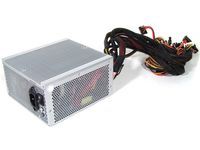Silent PSUs: Fortron Versus Silverstone
Silverstone Nightjar 450

The Nightjar 450 from Silverstone, which is also listed in shops under the name ST45NF, has a maximum nominal performance rating of 450 watts (a higher peak load is not specified by the manufacturer). The basic construction of the power supply, with a large aluminum cooling element, corresponds to that of the Fortron unit.

When it comes to connections, Silverstone has invested in the future somewhat. As a result, there are six SATA connections on the unit, along with six 4-pin Molex connections. The white-grey color combination reminds you of days gone by, but when hunting around in a tower for the right connections, you realize that the different SATA connection colors are practical.

The CPU connection is split, and can thus be used to suit both four- and eight-pin requirements. Silverstone has also employed this method for the PCIe connections: two six-pin connections are available, one of which can be extended to an eight-pin connection for modern graphics cards. The ATX connection is split in this way, and offers options with both 24-pin and 20-pin connections.
Silverstone has also not scrimped on the cable lengths; the ATX connection has a cable over 21” (55 cm) in length.
Stay on the Cutting Edge
Join the experts who read Tom's Hardware for the inside track on enthusiast PC tech news — and have for over 25 years. We'll send breaking news and in-depth reviews of CPUs, GPUs, AI, maker hardware and more straight to your inbox.
Current page: Silverstone Nightjar 450
Prev Page Efficiency Next Page Silverstone Nightjar 450 (Continued)-
knowom I think they'd be great for a digital audio workstation environment now if only there was some more competition in this market segment to drive prices down to a more decent level.Reply -
mdmadph "The +12V CPU connection is only available as 4-pin version, which can lead to problems with some boards that require an 8-pin connection."Reply
Know of many HTPC boards that need an 8-pin CPU connection? :\ I sure don't. -
I have read 3-4 other reviews of the zen 400W, and I'm pretty sure there has been no mention of the high pitched sound. It's not a good sign for the zen, but it's probably a faulty powersupply tested in this review.Reply
-
gwolfman Ummmm, so where's the temps? The review is practically pointless without temp measurements on a fanless PSU. BOOOOO!Reply -
jeffunit Without specifying the input voltage, efficiency measurements are pretty useless. Running at 240v will yield a few percent higher efficiency than 120. Even 240v will be more efficient than 220v.Reply -
kittle Re-run your review and include tempratures. Its pointless w/o them.Reply
If you have found a fanless PSU thats safe to touch -- thats great. but if these things get to 40, 50, 60c - then we need to know not to buy them. -
I own the Zen400 power supply and it's exactly what I needed for a quiet HTPC, to the point where it's literally impossible to tell when the PC is on. During normal operation I have never heard the high pitched sound this review mentions (although it did output a sound similar in volume and annoyance to a smoke alarm when I failed to plug in the power cable to the graphics card - it was clearly an error/failure tone).Reply
-
In regards to the lack of the 8 pin CPU 12v connector, if you can find a motherboard of which the 4 +12v pins of the port are not electrically connected, please point it out to actually justify needing the 8 pin connector. To be honest, a motherboard with a single +12v pin isolated to only 1 or 2 vcore phases would'nt be any motherboard you would want to purchase, for power efficiency reasons.Reply
-
Alternator I agree with the above posters, temps would be nice, and not just of the PSU...Reply
I am quite interested in getting a capable (above 400watt) PSU that doesn't require a fan, but I really need to keep an eye on the temperatures.
I have a fanless mb and vid card (3850 radeon), and would wonder if adding a fanless psu into the mix would jeopardise the system by reducing the air flow through the case. (after all I wouldn't get a fanless PSU if my other components were noisy to begin with!?)
Perhaps an article focused more on configuring a quiet computer (for the purpose of gaming) could be in order?
Most Popular

